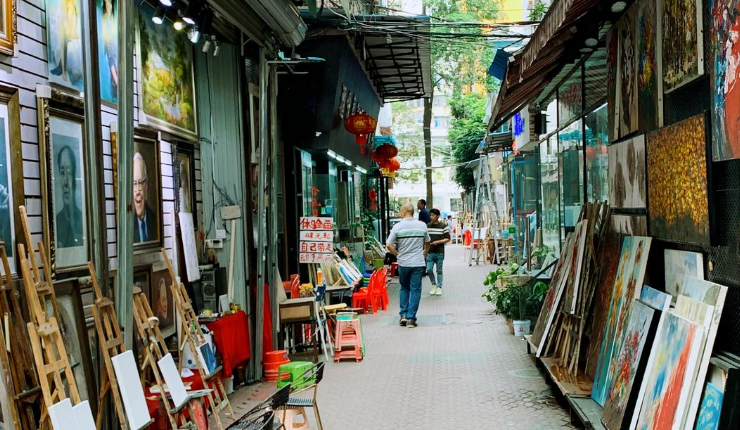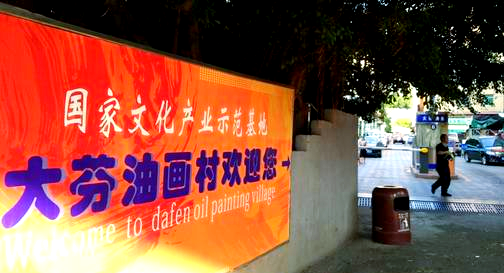Dafen oil painting Village
Shenzhen’s Dafen Village: What Stories Lie Behind These Countless Oil Paintings?
You might think the exquisite oil paintings hanging in luxurious living rooms, upscale hotels, and private clubs are all masterpieces created by renowned artists. But what you may not know is that many of these artworks originate from a small village in Shenzhen—Dafen Village. Here, countless artists and craftsmen work day and night, turning brushes into tools of life, weaving dreams and stories into every stroke. Though not painted by old masters, these works still carry the soul of art and the dedication of artisans.
Welcome to Dafen, Shenzhen’s world-famous oil painting hub, once hailed as the “Number One Oil Painting Village in the World.” At its peak, Dafen accounted for up to 70% of the global oil painting market. But in recent years, as China’s financial market slowed and export trade faced obstacles, the artists who once thrived on mass production of replicas now face a tough choice: cling to the past or embrace transformation?
Back in 2009, a young man named Xiaoping graduated from an art academy with dreams of becoming a true artist. He arrived in Dafen during its golden age, when the market was booming, clients were plentiful, and opportunities seemed endless. But fresh out of college, Xiaoping knew nothing about commercial oil painting.
He began by apprenticing under a master, copying famous paintings from reference images. Like a human photocopier, he would complete three to four small pieces a day—or even a large 1.2m x 1.2m canvas in a single session.
At first, he had to paint while constantly checking his phone or iPad for reference. But over time, like many others, he grew so familiar with the process that he could paint while casually puffing smoke rings, barely looking at the model.
The results weren’t always high quality. Xiaoping admits he used to worry that customers might be dissatisfied. But he soon realized that many artists were reproducing the same images, and even middlemen struggled to tell who had painted which copy. Eventually, he stopped worrying about quality altogether.
For a while, this kind of work brought decent income—enough for Xiaoping to buy an apartment in Shenzhen. Still, he never felt truly fulfilled. He knew deep down that this kind of high-replication painting was more about craftsmanship than artistry. The money was tempting, but it was not the life of a painter he had once envisioned.
The Secret to Dafen’s Wealth
In the late 1990s, a visionary art dealer from Hong Kong founded a commercial painting workshop in Shenzhen. He rented a local house with a team of a dozen painters, kickstarting what would become a thriving oil painting industry. With support from the local government, Dafen quickly attracted a flood of capital and talent, growing into a nationally and internationally recognized hub.
According to the latest report from the Shenzhen Special Zone Daily, Dafen Village is now home to over 1,200 galleries and art-related shops, covering a wide range of categories centered on oil painting. More than 20,000 people work in Dafen’s cultural industries, and around 70% are involved in the oil painting business. The village also includes shops selling Chinese ink paintings, calligraphy, frames, canvases, pigments, and other supplies that keep the creative ecosystem thriving.
Perhaps most impressively, Dafen has fostered over 300 original artists, including 24 members of the China Artists Association, 50 at the provincial level, and over 150 at the municipal level. Their works have added vibrant color and originality to the village’s growing art legacy.
A stroll through Dafen reveals more than just oil paintings. You’ll find traditional Chinese art, calligraphy, sculpture, embroidery, and modern cultural products all blending together. Each shop juggles a mix of imitation, original works, wholesale and retail sales, supported by stable customer bases. Together, they form a bustling artistic economy. But as competition intensifies and market dynamics shift, Dafen now faces a pivotal turning point.
Price Gaps and Market Pressures
A 1.5m x 1.5m oil painting in Dafen might sell for anywhere between 600 and 6,000 yuan, depending on the style, execution, and artist’s skill. A 60cm x 60cm piece could cost from a few hundred yuan down to mere tens. The pricing spectrum is vast.
According to veteran painter Lao Song, prices have dropped significantly compared to the golden years around 2010. Back then, orders flowed in from China, Europe, the U.S., and the Middle East. Artists had barely enough time to use the restroom, let alone refine their work. Middlemen capitalized on the frenzy, pushing prices up and hiring artists at premium rates—until the bubble burst.
Like Xiaoping, Mao Gong from Hainan also came to Dafen with dreams of artistic achievement. He quickly learned that talent alone wasn’t enough—he needed the guidance of an experienced mentor to gain credibility. But in recent years, especially the past three, business has grown cold. Some days, not a single order arrives. Price cuts failed to bring relief; instead, they slashed already thin margins even further.
The key problem is not only declining export orders but also sluggish domestic demand. Unlike basic consumer goods, oil paintings—often considered luxury décor—aren’t seen as necessities, especially in a downturn. Yet the biggest burden artists face is not lack of buyers, but rising costs. Rent for a 10-square-meter storefront, once 1,300 yuan/month, has risen to 2,000 yuan. Add to that increasing utility bills and food prices, and many artists are now dipping into savings just to survive the off-season.
Where Is Dafen Headed?
In response, the local government is encouraging a shift from mass replication to diversified, creative industries—incorporating calligraphy, traditional Chinese painting, sculpture, and cultural crafts.
Many painters are now moving toward high-end, original work, contributing to the wide price range of paintings in Dafen today. Artists like Xiaoping have returned to their roots, pursuing realist creations inspired by real-life scenes. His new works—vibrant reinterpretations of photographs—now adorn the walls of his shop, priced between 600 and 1,500 yuan.
He jokes that it still takes a day to complete a piece, but now he earns far more than the 300 yuan he once made for a copy. Through his online store, customers send him reference photos and give him creative freedom. “This is the right path for me now,” Xiaoping says. He dreams of traveling to paint what he sees—not just copying photos in a studio.
Then there’s Lao Chen and his family, also from Hainan, who found their own path forward. Ten years ago, Lao Chen’s son became a painter in Dafen and slowly built up wealth. With keen business sense and a willingness to innovate, the family opened a gallery focused on original work by themselves and their peers. Their diverse offerings—realist, modern, classical, calligraphy, Chinese painting—attract a steady flow of buyers. Today, they run three successful storefronts.
Other painters are turning to education, opening local art classes or offering remote lessons online—teaching while promoting their own works.
More and more are aiming at the high-end market, entering competitions to build their names. Gone are the days of soulless replication; these artists are developing distinct personal styles. “Every order is hard-earned now,” one said. “We can’t just wait for customers—we have to go out and win them.”
A Promising Future
Despite the challenges, Dafen Village is on the cusp of transformation. The government has drafted a Comprehensive Development Plan for the Dafen Oil Painting Industry Base, aiming to reshape the area over the next 3 to 5 years. As part of a broader urban renewal project, the plan envisions new museums, theaters, training centers, and hotels.
In partnership with the tourism bureau, Dafen will also develop its unique appeal as a cultural destination. The goal: to evolve Dafen into an international hub for oil painting production, trade, exhibitions, education, and tourism—a vibrant town where tradition meets innovation.


